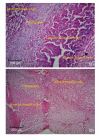Saline conducted electric coagulation (SCEC): original experience in experimental hepatectomy
- PMID: 22374610
- PMCID: PMC3296069
- DOI: 10.1631/jzus.B1100096
Saline conducted electric coagulation (SCEC): original experience in experimental hepatectomy
Abstract
Objective: To evaluate the feasibility and superiority of a new coagulating and hemostatic method named "saline conducted electric coagulation (SCEC)".
Methods: The Peng's multifunction operative dissector (PMOD) was modified to enable saline to effuse persistently out of its nib at a constant speed. In a group of six New Zealand rabbits, two hepatic lobes of each rabbits were resected respectively by SCEC and conventional electric coagulation (EC). The features of SCEC were recorded by photo and compared with conventional EC. After 7 d, the coagulating depth was measured in each residual hepatic lobe. Hepatic tissue was dyed by hematoxylin and eosin (HE) and studied under a microscope.
Results: The coagulating depth increased with the continuation of SCEC time. Hepatectomies were performed successfully, no rabbit died in the perioperative period. The incisal surface of SCEC was gray-white with no red bleeding point. There was a thick solidified layer at the margin and a thin red-white intermittent layer between the solidified layer and normal hepatic tissue at the vertical section of SCEC. The mean coagulating depth of SCEC was 1.8 cm vs. 0.3 cm of conventional EC. Pathological examination showed a mild inflammatory reaction by SCEC.
Conclusions: SCEC is a feasible and safe method for surgical hemostasis. As a new technique for liver resection, SCEC shows better coagulating effect and milder inflammatory reaction than conventional EC. Our study shows bloodless liver resection can also be performed by SCEC, especially for liver malignant tumor.
Figures






Similar articles
-
Laparoscopic liver resection using a monopolar soft-coagulation device to provide maximum intraoperative bleeding control for the treatment of hepatocellular carcinoma.Surg Endosc. 2018 Apr;32(4):2157-2158. doi: 10.1007/s00464-017-5829-x. Epub 2017 Sep 15. Surg Endosc. 2018. PMID: 28916868
-
Liver resection using a soft-coagulation system without the Pringle maneuver.Hepatogastroenterology. 2012 May;59(115):875-7. doi: 10.5754/hge11101. Hepatogastroenterology. 2012. PMID: 22024227
-
High-intensity focused ultrasound (HIFU)-assisted hepatic resection in an animal model.Ann Surg Oncol. 2012 Jul;19 Suppl 3:S447-54. doi: 10.1245/s10434-011-1875-0. Epub 2011 Jul 28. Ann Surg Oncol. 2012. PMID: 21796492
-
Methods of vascular control technique during liver resection: a comprehensive review.Hepatobiliary Pancreat Dis Int. 2010 Oct;9(5):473-81. Hepatobiliary Pancreat Dis Int. 2010. PMID: 20943455 Review.
-
Minimizing blood loss during hepatectomy: a literature review.J Surg Oncol. 2014 Feb;109(2):81-8. doi: 10.1002/jso.23455. Epub 2013 Oct 4. J Surg Oncol. 2014. PMID: 24449171 Review.
Cited by
-
The clinical efficacy of "water-jet" hemostasis in gastrointestinal endoscopic submucosal dissection.Gastroenterol Rep (Oxf). 2024 Sep 26;12:goae088. doi: 10.1093/gastro/goae088. eCollection 2024. Gastroenterol Rep (Oxf). 2024. PMID: 39345296 Free PMC article.
References
-
- Aoki T, Kato T, Yasuda D, Shimizu Y, Murai N, Sato A, Koizumi T, Otsuka K, Kusano T, Hayashi K, et al. Cyst wall resection and ablation by hand-ssisted laparoscopic surgery combined with argon plasma coagulator for huge hepatic cysts. Int Surg. 2007;92(6):361–366. - PubMed
Publication types
MeSH terms
Substances
LinkOut - more resources
Full Text Sources
Research Materials

